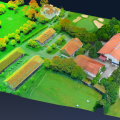WAL MAYR
Airborne laser scanning is a relatively recent technology that has revolutionised the capture of terrain information. It involves the emission and measurement of laser pulses from an airborne scanner. Until recently, it was mainly used to capture large areas of relatively low-resolution digital terrain data. However, in the past few years a range of second-generation scanners has entered the market. Some of these new units have characteristics that support the capture of very accurate terrain and feature data, making them ideal for mapping detailed contours, vegetation, and infrastructure such as powerlines and open-cut mines.
We have recently adopted one of these new scanners. Although it proved to be a successful decision, making it required significant research. It also involved deciphering contradictory and highly technical specifications for scanners which were on the market. The following provides simplified information about such characteristics. It may help potential users to better understand the technology in general, and also help distinguish between the growing numbers of scanners now available.
One of the key differentiators between scanners is the pulse rate. High pulse rates mean that there are more points to define the ground directly, or penetrate vegetation to define it.
Increasingly, tenders are specifying a required number of points per square metre. But the important issue is the number of points that actually reach the ground. In dense vegetation, achieving a density of a point per square metre on the ground is only possible if five or more points per square metre are hitting the surface of the vegetation.
Point densities of twenty points per square metre and above may be necessary to carry out detailed engineering surveys, and to capture features such as thin earth wires on power lines or the full extent of areas of mining subsidence.
A second issue is the question of the safety of the eyes of people on the ground below the aircraft. Many scanners are not legally allowed to fly at low altitudes because of the potential harmful effects of the laser pulses.
Scanners fitted with Class 2 lasers can fly at any height. This is a major advantage where highly detailed data or regular revisits are required, because low flying heights produce even higher ground point densities.
Low flying also makes it possible – very importantly – to fly under the clouds. Delays usually caused by wet weather are avoided, which in turn increases reliability in time-critical repeat surveys.
Another key issue that is becoming more important is full wave form detection. It is inherently more accurate in complex terrain, where surfaces are not flat and perpendicular to the beam. Leading edge and other detection methods used in some scanners are prone to errors on steep surfaces.
Post-processing of full wave form also allows much more detailed analysis of the signal to determine the precise position of objects that intercept each pulse. As well as identifying the beginning and end of the echo, it also provides multiple intermediate measurements. As illustrated in Figure 3, these can be used for detailed modelling of complex infrastructure and vegetation.
It is therefore possible not only to have a higher pulse rate, but also more information per pulse. The quantity and precision of three-dimensional information derived from full wave form detection is orders of magnitude greater than the information from scanners that return the average signal intensity for predefined intervals.
Pulse length dictates the minimum distance between detectable objects. A long pulse length – as in older systems – increases the probability of a misinterpreted ground hit. A pulse length of less than 4 ns using full wave form recording can record objects that are less than 0.6 metres apart, and has the best ability to distinguish between the ground and understorey vegetation.
Another consideration is the use of a polygon mirror configuration in the scanner. This method of scanning the laser pulses delivers an even point distribution, in a square pattern. This produces the highest statistical likelihood of achieving an accurate digital terrain model.
Some scanners can produce high point densities across track, but have large gaps between lines, that is, along the path. During processing, the surface is interpolated between the laser pulses. The greater the distance, the higher likelihood of missing small features and structures.
The polygon mirror configuration is also extremely stable. It minimises the need for repeat calibration of the equipment, thereby reducing turnaround times and cost.
A medium format camera is a useful addition to the instrument. It can take photographs of the same footprint as the scanner. This results in simultaneous capture of imagery and terrain data, avoiding the need for two flights. Although not designed to produce high quality orthophotography, it does provide rapid access to rectified imagery for reference. It is especially useful when digitising break lines or feature lines is required.
The spot size on the ground also matters. Laser beam divergence combined with flying height dictates the spot size on the ground. All measurements are referenced back to the centre of the beam. If the spot size is too large, excessive horizontal errors are generated. If it is too small, the chances of obtaining reflections from the ground are decreased.
At a flying height of 700 metres, a divergence of 0.5 mrad results in a spot size on the ground of 0.25–0.5 metres, which is optimum for detailed terrain and infrastructure capture.
Technology is evolving at a rapid rate. As a result, many users may have trouble interpreting information from contractors about the features of all the different scanners on offer, and deciding which is the most appropriate for their requirements.
This article has attempted to demystify and clarify some of their features, particularly for users interested in detailed mapping of terrain, vegetation and infrastructure.
Wal Mayr is a director of Terranean Mapping Technologies in Brisbane.
Issue 36; August – September 2008







